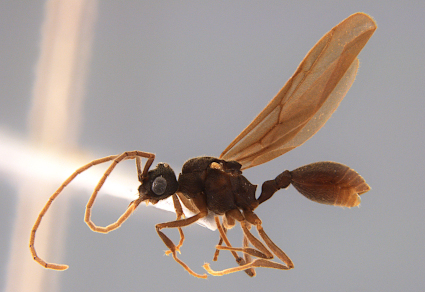References
- Barros, L.A.C., Rabeling, C., Teixeira, G.A., Mariano, C. dos S.F.M., Delabie, J.H.C. & de Aguiar, H.J.A.C. (2022) Decay of homologous chromosome pairs and discovery of males in the thelytokous fungus-growing ant Mycocepurus smithii. Scientific Reports, 12, 4860. https://doi.org/10.1038/s41598-022-08537-x
- Boudinot, B.E. (2019) Clave para las subfamílias y géneros basada en machos. In: Fernández, F., Guerrero, R. J. & Delsinne, T. (Eds.), Hormigas de Colombia. Universidad Nacional de Colombia, Bogotá, Colômbia, pp. 487–499.
- Boudinot, B.E. (2013) The male genitalia of ants: Musculature, homology, and functional morphology (Hymenoptera, Aculeata, Formicidae). Journal of Hymenoptera Research, 30, 29–49. https://doi.org/10.3897/jhr.30.3535
- Branstetter, M.G., Ješovnik, A., Sosa-Calvo, J., Lloyd, M.W., Faircloth, B.C., Brady, S.G. & Schultz, T.R. (2017) Dry habitats were crucibles of domestication in the evolution of agriculture in ants. Proceedings of the Royal Society B: Biological Sciences, 284, 20170095. https://doi.org/10.1098/rspb.2017.0095
- Chaul, J.C.M. (2022) Redescription of Eurhopalothrix reichenspergeri (Santschi, 1923) stat. rev.(Hymenoptera: Formicidae), a Brazilian Atlantic Forest endemic species. Zootaxa, 5182 (1), 1–20. https://doi.org/10.11646/zootaxa.5182.1.1
- Dias, A.M. & Lattke, J.E. (2021) Large ants are not easy – the taxonomy of Dinoponera Roger (Hymenoptera: Formicidae: Ponerinae). European Journal of Taxonomy, 784,1–66. https://doi.org/10.5852/ejt.2021.784.1603
- Eberhard, W.G. (1985) Sexual Selection and Animal Genitalia. Harvard University Press, Boston, Massachusetts, 244 pp. https://doi.org/10.4159/harvard.9780674330702
- Forel, A. (1893) Note sur les Attini. Annales de la Société Entomologique de Belgique, 37, 586–607.
- Hanisch, P.E., Sosa-Calvo, J. & Schultz, T.R. (2022) The last piece of the puzzle? Phylogenetic position and natural history of the monotypic fungus–farming ant genus Paramycetophylax (Formicidae: Attini). Insect Systematics and Diversity, 6, 11. https://doi.org/10.1093/isd/ixab029
- Heinze, J., Trindl, A., Seifert, B. & Yamauchi, K. (2005) Evolution of male morphology in the ant genus Cardiocondyla. Molecular Phylogenetics and Evolution, 37, 278–288. https://doi.org/10.1016/j.ympev.2005.04.005
- Ješovnik, A. & Schultz, T.R. (2017) Revision of the fungus-farming ant genus Sericomyrmex Mayr (Hymenoptera, Formicidae, Myrmicinae). ZooKeys, 670,1–109. https://doi.org/10.3897/zookeys.670.11839
- Kempf, W.W. (1963) A review of the ant genus Mycocepurus Forel, 1893 (Hymenoptera: Formicidae). Studia Entomologica, 6, 417–432. https://doi.org/10.15468/sxkscg
- Kerr, W.E. (1961) Acasalamento de rainhas com vários machos em duas espécies da tribu Attini (Hymenoptera, Formicoidea). Revista Brasileira de Biologia, 21, 45–48.
- Mehdiabadi, N.J. & Schultz, T.R. (2010) Natural history and phylogeny of the fungus-farming ants (Hymenoptera: Formicidae: Myrmicinae: Attini). Myrmecological News, 13, 37–55.
- Rabeling, C. & Bacci, M. (2010). A new workerless inquiline in the lower Attini (Hymenoptera: Formicidae), with a discussion of social parasitism in fungus–growing ants. Systematic Entomology, 35, 379–392. https://doi.org/10.1111/j.1365-3113.2010.00533.x
- Rabeling, C., Gonzales, O., Schultz, T.R., Bacci Jr., M., Garcia, M.V., Verhaagh, M., Ishak, H. & Mueller, U.G. (2011) Cryptic sexual populations account for genetic diversity and ecological success in a widely distributed, asexual fungus–growing ant. Proceedings of the National Academy of Sciences, 108, 12366–12371. https://doi.org/10.1073/pnas.1105467108
- Rabeling, C., Lino-Neto, J., Cappellari, S.C., Dos-Santos, I.A., Mueller, U.G. & Bacci Jr., M. (2009) Thelytokous parthenogenesis in the fungus–gardening ant Mycocepurus smithii (Hymenoptera: Formicidae). PLoS One, 4, e6781. https://doi.org/10.1371/journal.pone.0006781
- Snodgrass, R.E. (1941) The male genitalia of Hymenoptera. Smithsonian Miscellaneous Collections, 99 (14), 1–86. https://doi.org/10.5281/zenodo.54867
- Tozetto, L. & Lattke, J.E. (2020) Revealing male genital morphology in the giant ant genus Dinoponera with geometric morphometrics. Arthropod Structure and Development, 57, 100943. https://doi.org/10.1016/j.asd.2020.100943
- Yoshimura, M. & Fisher, B.L. (2012) A revision of male ants of the Malagasy Amblyoponinae (Hymenoptera: Formicidae) with resurrections of the genera Stigmatomma and Xymmer. PLoS One, 7, e33325. https://doi.org/10.1371/journal.pone.0033325


